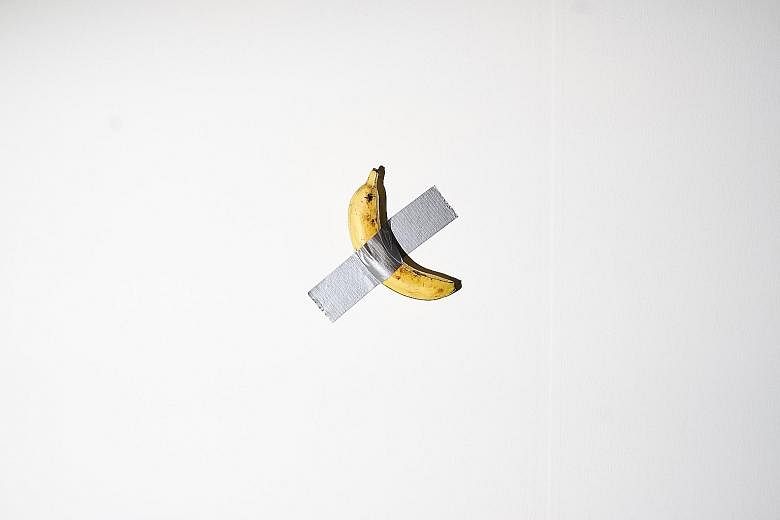NEW YORK • Few artworks sold in the past few years have drawn as much attention as Comedian by Italian artist Maurizio Cattelan, in part because, despite its price and ironic humour, it is at its heart a banana that one tapes to a wall.
The sly work's simplicity enticed collectors to pay as much as US$150,000 (S$203,500) for it at a Miami art fair last year, an act of connoisseurship that delighted them but astonished the many people who had not imagined that a "sculpture" of fruit on a wall could command such a price.
Now, the work's aesthetic merit is being reinforced by the Guggenheim Museum in Manhattan, which is accepting it into its collection as an anonymous donation.
"We are grateful recipients of the gift of Comedian, a further demonstration of the artist's deft connection to the history of modern art," said the Guggenheim's director Richard Armstrong. "Beyond which, it offers little stress to our storage."
In fact, Comedian, as sold, does not include a banana or tape.
What one buys is a "certificate of authenticity", a surprisingly detailed, 14-page list of instructions, with diagrams, on how the banana should be installed and displayed.
Ms Lena Stringari, the Guggenheim's chief conservator, said the instructions will be quite easy to follow in addressing questions like how often to change bananas (seven to 10 days) and where to affix them ("175cm above ground").
The conservation of conceptual art is not always so straightforward for museums increasingly asked to preserve works made from all kinds of ephemeral substances, like food.
How does one care for a scale model of an Algerian city made out of couscous? A sculpture made of interlocking tortillas? Fruit stuck on a coatrack? (All works the Guggenheim has shown.)
Given the expectation that museums will preserve works for generations, centuries, maybe even forever, the host of tricky questions that surfaces around this sort of work goes beyond the more typical concerns of how to touch up an oil painting or mend a crack in a sculpture.
How do you preserve a balloon that contains the artist's breath (it's called Artist's Breath) and that inevitably is going to deflate? (Tate Modern.) What about computer-based art when the computer or its software is out of date and cannot work anymore? Or the many pieces that have been created from fluorescent lights when the fluorescent lights are no longer manufactured?
The answer, for some, is as high-concept as the art.
"Once you think art is an idea and the material is secondary, then it does not matter if that material lasts for a long time," said Ms Melissa Chiu, director of the Hirshhorn Museum and Sculpture Garden at the Smithsonian in Washington.
The Hirshhorn has its own conservation specialists who tend to art created from "time-based" materials that degrade.
The focus is so much on the idea that, in some cases, the materials do not outlast the end of the exhibition. Like the works involving bananas or couscous, the art object is thrown away but the art idea lives on, to be recreated in the future according to the artist's instructions.
A famous example of art created from organic matter is Yoko Ono's 1966 Apple, featuring an apple on a plexiglass pedestal.
When it was shown at the Museum of Modern Art in 2015, the apple was bought from a store on 53rd Street and replaced a couple of times over the four weeks of the exhibition, said Mr Christophe Cherix, one of the curators who put on the show.
At the Guggenheim for a 2016 show, Ms Stringari and the museum's staff cooked couscous according to artist Kader Attia's recipe, along with wallpaper paste and salt to keep it together and deter mould. Her staff, with the help of the artist, used stainless-steel moulds to recreate the model of the desert city of Ghardaia, which Attia designed as a commentary on colonialism.
The city inspired Western architects, but they rarely acknowledged its influence.
Over the three months of the exhibition, the museum team monitored the sculpture for pests like bugs. Cracks appeared, but that was one of the points, mirroring the age of the ancient city. Any couscous that fell away was swept up.
The ideas underpinning ephemeral art often inevitably include concepts like loss, mortality, life and death.
In the case of Comedian, the subject is also the art world itself - and questions about who decides what constitutes art and the huge amounts of money spent on it.
One of the buyers, Ms Sarah Andelman, a French fashion consultant and tastemaker, wrote in an e-mail: "It appealed to me for its absurdity and the effect on the public. I observed all the Basel visitors taking their selfie and I thought that was such a reflection of our time."
She said she has not hung her Comedian yet. She is still waiting for the instructions, but added she is in no rush. "What I think I bought is an idea, a concept more than a banana with tape," she said.
There is no word yet when the Guggenheim will display it.
NYTIMES

